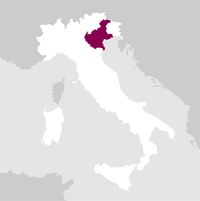Description
Le Bottega White Gold est un DOC Venezia, obtenu à partir de la vinification des raisins Glera, Chardonnay et Pinot. C'est un vin mousseux Brut de grand caractère, frais et élégant, expression du territoire dont les raisins sont originaires, entre les provinces de Trévise et de Venise.
Récompenses
Détails

Perlage

Parfum

Couleur

Goût
Servir à :
06 - 08 °C.
Longévité :
03 - 05 ans

Accords
- Année de création: 1977
- Oenologue: Fabrizio Dorigo
L'engagement de Bottega en matière de développement durable est également primordial : l'entreprise recycle le papier siliconé, utilise au moins 85 % de bouteilles noires en verre recyclé, choisit des peintures à base d'eau pour les bouteilles métallisées, respecte les critères de l'agriculture biologique dans ses vignobles et incorpore des plastiques recyclés dans l'océan. En outre, l'entreprise n'utilise que de l'énergie 100 % renouvelable. Lire la suite


| Nom | Bottega White Gold Venezia |
|---|---|
| Type | Blanc vert vin mousseux méthode charmat brut |
| Dénomination | Venezia DOC |
| Format | 0,75 l |
| Teneur en alcool | 11.0% par volume |
| Cépages | Chardonnay, Glera, Pinot Bianco, Pinot Grigio, Pinot Meunier, Pinot Nero |
| Pays | Italie |
| Région | Vénétie |
| Fournisseur | Bottega |
| Origine | La zone DOC Venezia s'étend des contreforts de la province de Trévise à la mer Adriatique (province de Venise), c'est-à-dire des collines de Conegliano à la lagune de Caorle |
| Climat | Le climat est de type "tempéré humide", grâce à la protection offerte au nord par la proximité des Dolomites et à la proximité de la mer et des lagunes. |
| Composition du sol | Les sols sont constitués de matériaux alluviaux provenant de la fonte des glaciers alpins et préalpins et transportés par les rivières Piave et Livenza. La zone de la haute plaine présente une forte concentration de galets et de graviers qui rendent le sol léger, drainant et peu fertile, caractéristiques optimales pour la culture de la vigne. C'est dans ces zones que sont cultivés les raisins de haute qualité qui donnent vie à ce vin pétillant. |
| Système de culture | Sylvoz |
| Plantes par hectare | 2500 - 3000 |
| Rendement par hectare | 140 q. |
| Récolte | Les grappes des trois cépages qui composent l'assemblage sont généralement récoltées vers la mi-septembre. Les raisins sont amenés rapidement à la cave afin de préserver leur qualité et d'éviter les altérations qui pourraient être causées par : des dommages mécaniques, une oxydation précoce, une contamination microbienne, l'exposition au soleil. |
| Vinification | L'égrappage, le pressurage doux des raisins pour séparer les peaux du moût et enfin la décantation ou le nettoyage du moût sont effectués. Environ 5 % de la cuvée de départ comprend une période de barrique de 6 mois. Les barriques utilisées pour ce vin sont pour certaines en chêne français moyennement grillé et pour d'autres en bois d'acacia légèrement grillé. Le chêne français est un bois qui donne au vin de l'élégance et des tanins nobles, tandis que l'acacia apporte de la douceur et des tanins moins agressifs, avec un bouquet rappelant le miel et la vanille. La première fermentation s'effectue dans des cuves en acier, suivie de l'ajout de levures sélectionnées. |
| Vieillissement | Basée sur la méthode Martinotti, la deuxième fermentation a lieu dans un autoclave, une cuve spéciale en acier pressurisé qui permet un contrôle précis de la pression et de la température, maintenue à 14 °C pour préserver le parfum et les arômes typiques des raisins d'origine. Au cours de la transformation des sucres en alcool, les levures libèrent naturellement du dioxyde de carbone, qui se dissout dans le vin, le rendant ainsi "pétillant". À la fin du processus de pétillance, le vin est stabilisé à froid, filtré et mis en bouteille. |
| Allergènes | Contient des sulfites |






